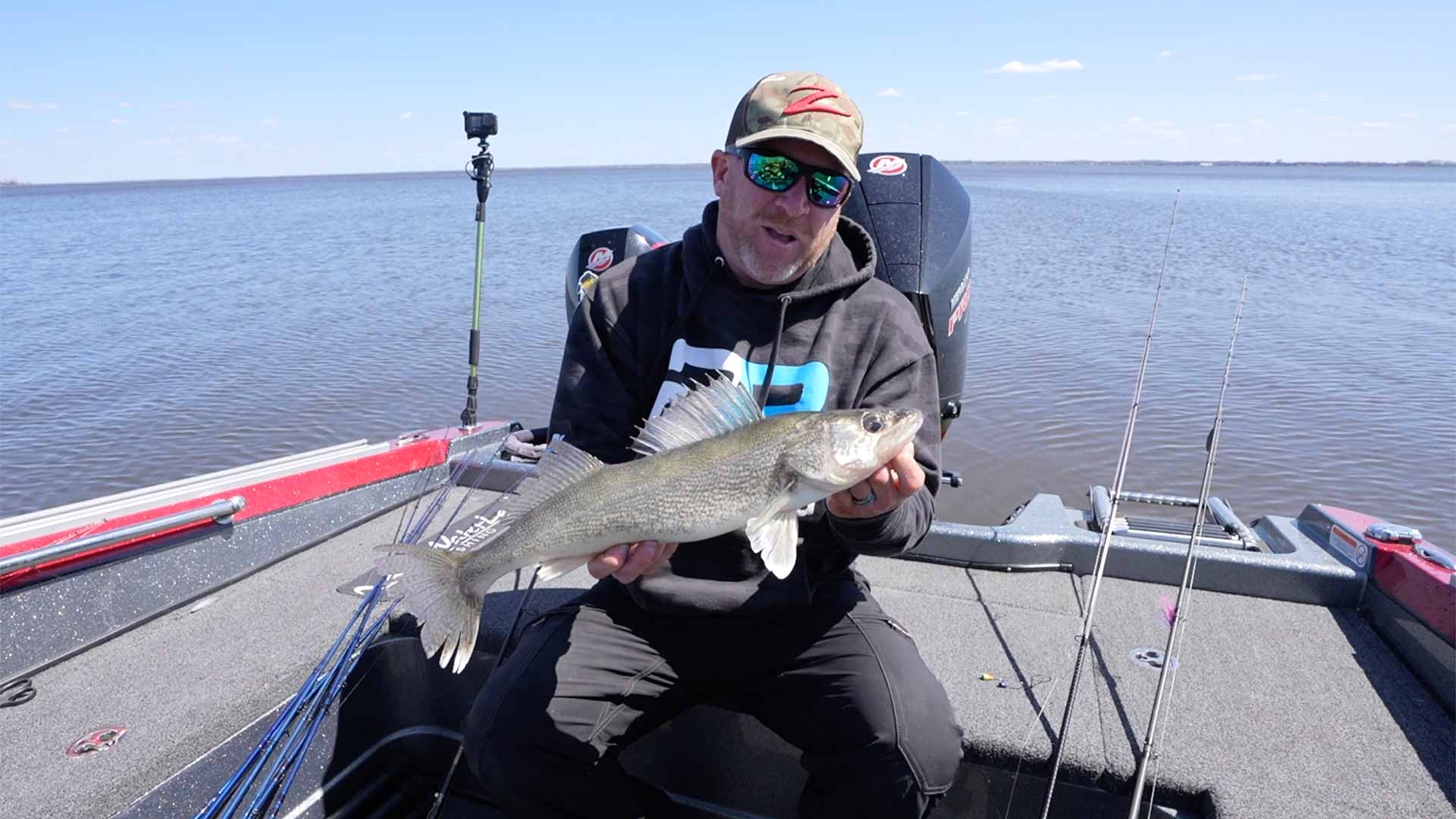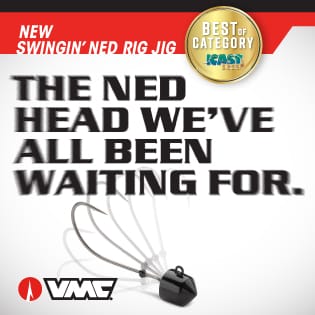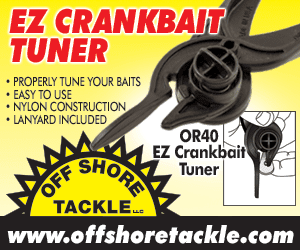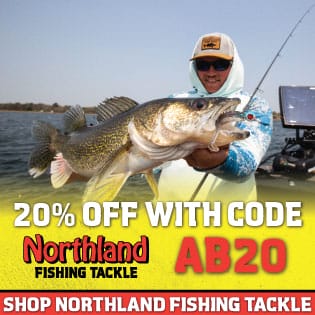Every lures has it’s time and place, and the deeper your arsenal of presentations, the more versatile you can be as a fisherman.
When it comes to catching walleye, there are numerous techniques and baits that can be effective. In this article, we will explore the different situations in which various lures are most successful. To provide expert insights, we have enlisted the help of Joel Nelson, an experienced angler. Whether you prefer jigging, casting crankbaits, trolling, or using live bait rigs, we’ve got you covered. Let’s dive in and discover the best lures for walleye fishing!
Jigging Raps: A Vertical Presentation for Aggressive Fish
Jigging Raps are an excellent choice when targeting walleye in deep water. These lures are heavy and fish well in depths of 20 feet or more. Joel recommends using jigging wraps when walleye are off the bottom and displaying aggressive behavior. The fish are often visual eaters on the prowl, ready to hunt in these situations. Jigging Raps are a go-to lure if you’re trophy hunting for big walleye.
Crankbaits: Ideal for Shallow Water with Consistent Wind
Casting crankbaits is a technique that Joel has found success with, particularly on rivers like Lake Pepin. He suggests using crankbaits when there is a consistent wind of 10-15 miles per hour or higher. Shallow fish are often more active and feeding in these conditions, making crankbaits an effective choice. With the wind at your back, you can cast crankbaits towards the shoreline and entice walleye to strike.
Trolling Crankbaits: A Strategy for Finding Scattered Fish
Trolling crankbaits is a great way to locate walleye, especially in new fishing spots. By putting more baits in front of more fish, you increase your chances of success. Joel recommends trolling crankbaits when fish are scattered over large structural elements, such as long runs of contiguous contour depth levels or big sand breaks. This tactic allows you to cover a lot of ground and target walleye that are spread out over a distance.
Jigs: Precision-Based Extraction Method for School Fish
Jigs are a versatile lure that Joel uses when targeting pods of school fish. He considers jigs to be a precision-based extraction method, as they allow you to present the bait right over the top of tightly balled fish on structural elements. By dropping the jig back near the transducer, you increase your chances of enticing a strike. Joel suggests using jigs on smaller structural elements where fish are tightly grouped together.
Live Bait Rigs: A Preferred Choice for Rigging Fish
Joel has a preference for live bait rigging, as it allows him to focus on the dynamics of the rod tip and pay attention to the fish’s behavior. He enjoys pulling on rigged fish when they are moving and distributed across a larger area, such as mudflats or rock piles with inside turns. Live bait rigging is a moderate to slow tactic that covers more ground compared to jigging. It allows you to present the bait in a methodical manner and target walleye that are still potted up in groups. Joel finds live bait rigging to be just as effective as jigging, but with the advantage of being able to cover more ground.
Spinner Rigs: Ideal for Fishing in Mixed Water Columns
Pulling spinner rigs is a great technique when there is a mix of bugs, bait, and walleye throughout the bottom two feet of the water column. This tactic allows you to cover some ground while also slowing down and targeting specific groups of fish. Joel considers pulling spinner rigs to be a moderate speed tactic, falling somewhere between rigging and trolling crankbaits. It is a versatile approach that can be effective in various situations.
Blade Baits: A Hybrid Between Jigs and Crankbaits
Joel has had success fishing with blade baits, especially in walleye river current situations. Blade baits are heavy and can be fished like jigs, maintaining good bottom contact. They also produce a lot of vibration, making them effective in murky water. Joel describes blade baits as a hybrid between jigs and crankbaits, combining the best qualities of both lures. Walleye are attracted to the vibration and action of blade baits in these conditions.
Hair Jigs: A Versatile Lure for Shallow and Windblown Areas
Although Joel hasn’t been part of the hair jig craze, he recognizes their effectiveness in certain situations. Hair jigs can be fished vertically or cast shallow, similar to crankbaits. They are particularly useful on windblown days when casting rocky shorelines. When walleye aren’t actively feeding shallow, you can adjust the weight of the hair jig and fish it deeper and more methodically. Joel plans to invest more time into using hair j igs again, as he believes they can be a valuable addition to his fishing arsenal.
Spoons: A Technique Worth Exploring
While Joel personally hasn’t used spoons intentionally for walleye in open water, he acknowledges that they can be effective. He recalls catching walleye on spoons when trolling for pike as a kid. Although he hasn’t invested much time in this technique, he recognizes that it could be a valuable addition to his angling resume.
Plastics vs. Live Bait: The Temperature Factor
Joel is a big fan of using plastics whenever possible. He finds that live bait is more effective in the early part of the season when water temperatures are around 55 to 60 degrees Fahrenheit. However, once the water temperatures rise, plastics become the ultimate choice. Plastics allow for more aggressive and faster fishing, as they don’t require constant bait changes. Joel prefers using plastics for the majority of the summer, only resorting to live bait if the plastics aren’t producing results.
Lipless Crankbaits: Rattle and Vibration for Stained Water
Joel considers lipless crankbaits to be similar to blade baits, as they both provide a lot of vibration. He finds lipless crankbaits particularly effective in stained or murky water, where the rattles help walleye locate the bait. He recommends using lipless crankbaits, such as rip and wraps, in situations where you’re targeting big trophy fish in stained water.
Swim Baits: A Search Bait with Depth Control
Joel doesn’t fish swim baits extensively, but when he does, he finds them useful for casting in shallower water. Swim baits are a great search bait, as they can be fished at any depth. Joel suggests slow-rolling swim baits, reeling them in like crankbaits, for the best results. Swim baits offer excellent depth control, allowing you to adjust the depth based on the fishing conditions. They are a versatile option for targeting walleye in various situations.
In conclusion, Joel shares his insights on different fishing techniques and lures for walleye. Jigging wraps are ideal for deep water and aggressive fish behavior. Crankbaits are effective in shallow water with consistent wind, while trolling crankbaits can help locate scattered fish. Jigs are a precision-based extraction method for school fish, and live bait rigging allows for focused observation of fish behavior. Pulling spinner rigs is a versatile tactic for fishing in mixed water columns, and blade baits offer a hybrid approach between jigs and crankbaits. Hair jigs are versatile lures for shallow and windblown areas, and spoons are worth exploring as a technique. Plastics are preferred once water temperatures rise, and lipless crankbaits are effective in stained water. Swim baits offer depth control and are useful for casting in shallower water.
Joel’s expertise and experience provide valuable insights into the different techniques and lures that can be used to target walleye in various fishing conditions. Whether you’re fishing in deep water, shallow water, or dealing with different water column scenarios, there is a technique and lure that can help you increase your chances of success. It’s important to experiment with different techniques and lures to find what works best for you in different fishing situations.
So, the next time you’re out on the water targeting walleye, consider Joel’s advice and try out these different techniques and lures to see which ones work best for you. Happy fishing!
In this video, Joel Nelson explains where and how he uses a number of walleye fishing lures including:
0:22 – Jigging Raps
0:50 – Casting Crankbaits
1:32 – Trolling Crankbaits
2:22 – Walleye Jigs
3:00 – Livebait Rigs
3:58 – Spinner Rigs
4:38 – Blade Baits
5:18 – Hair Jigs
6:12 – Spoons
6:48 – Livebait vs Plastics
7:41 – Lipless Crankbaits
8:28 – Swimbaits
For more videos like this, Subscribe to our YouTube channel:

[/et_pb_text][/et_pb_column][/et_pb_row][/et_pb_section]
Every lures has it’s time and place, and the deeper your arsenal of presentations, the more versatile you can be as a fisherman. In this video, Joel Nelson explains where and how he uses a number of walleye fishing lures including:
0:22 – Jigging Raps
0:50 – Casting Crankbaits
1:32 – Trolling Crankbaits
2:22 – Walleye Jigs
3:00 – Livebait Rigs
3:58 – Spinner Rigs
4:38 – Blade Baits
5:18 – Hair Jigs
6:12 – Spoons
6:48 – Livebait vs Plastics
7:41 – Lipless Crankbaits
8:28 – Swimbaits
Thumbnail photo via Matt Addington.
For more videos like this, Subscribe to our YouTube channel:

[/et_pb_text][/et_pb_column][/et_pb_row][/et_pb_section]










